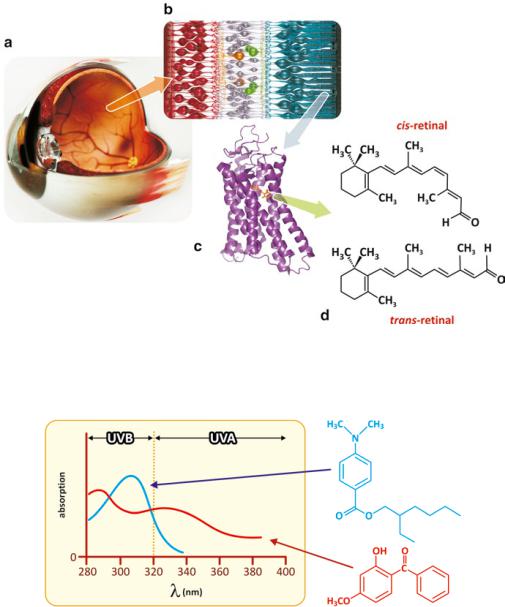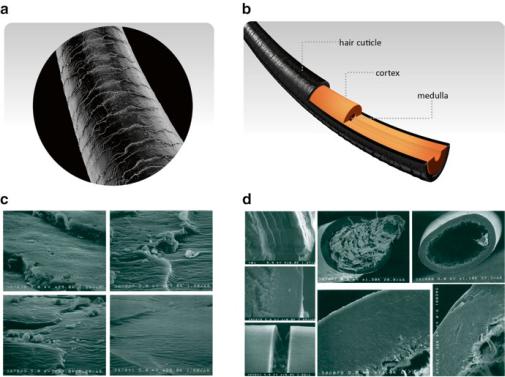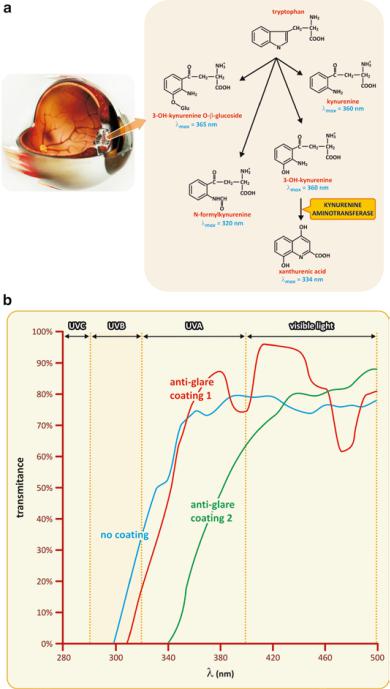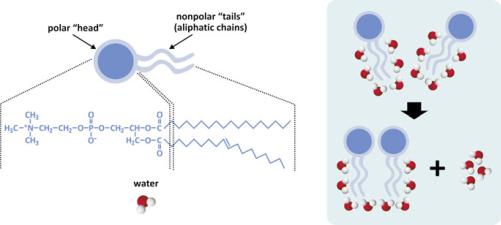
новая папка / Integrative Human Biochemistry_ A Textbook for Medical Biochemistry (PDF).pdf
.pdf
2.2 More than Only Chemistry: There Is Physics Too |
41 |
Fig. 2.11 (a) The electromagnetic spectrum with the typical frequencies of radiation, devices that use them, and their typical biochemical/physiological effects. The narrow range of optical radiation (in practical terms, the radiation that can be conducted using lenses and mirrors), to which human eyes are sensitive, is highlighted. (b) Spectrum of total solar radiation power that reaches Earth surface. The maximum power range is coincident with optical radiation one calls “visible light,” the radiation many animal eyes, including human, have adapted to. This radiation penetrates water down to tenths of meters, which was also important for the evolution of vision
A part of the UV-B radiation is also absorbed by ozone. Having sufficient energy to break chemical bonds in the nucleic acids of exposed cells in the skin layers near the surface, UV-C and, to a less extent, UV-B are serious health hazzards regarding skin tumors, mainly in prolonged exposure to sun and other UV sources. Whenever the ozone layer is threatened, the risk of skin cancer raises. Nevertheless, the immediate, most noticeable effects of UV-B are erythemas, such as those associated to “sunburns” in short-term solar overexposure. Being moderate to high-energy radiation, UV-C and UV-B interfere with many molecular processes. The consequence of this is that their penetrance is shallow in the skin (they are totally absorbed in the outer layers of skin—epidermis and nearby dermis; Fig. 2.13), where they are responsible for some naturally occurring biochemical processes, such as the conversion of the amino acid tyrosine in melanin (a sun radiation–protection pigment that colors the skin), but also by some lesions such as the detachment of epidermis from dermis (“sunburn blisters”). UV-A penetrates deeper in the skin because it is not so

42 |
2 The Chemistry and Physics of Life |
Box 2.2: The Toughest Cell on Earth
In 1956 Arthur Anderson, working in Oregon (USA), was studying if canned food could be sterilized using high doses of gamma radiation. Despite the fact that he was using doses enough to destroy all forms of life known to man to sterilize meat, the food subsequently spoiled. A bacterium, Deinococcus radiodurans, was isolated and found to be responsible for this result. Later studies revealed that it is extremely resistant to ionizing radiation of different frequencies, desiccation, and oxidizing agents. While a bacterium like E. coli can stand up to 200–800 Gy, D. radiodurans can stand up to 5000 Gy. Human cells have much lower tolerance levels: below 5 Gy.
From the chemical point of view, the DNA composition of D. radiodurans is not different from that of other organisms. The key to resistance is not the chemical nature of DNA but the efficacy of the repair mechanisms. Radiation interacts with the chemical bonds of the DNA similarly in all cells, causing occasional breakings in these bonds when its energy is high enough. It is impossible for the vast majority of cells to cope with very frequent and simultaneous breaking of the DNA covalent bonds. D. radiodurans, however, has its DNA packed in toroids and multiple copies of the genome, usually 4–10. The whole repair machinery enables the reconstruction of the complete genome from shattered bits in hours. Bacterium-to-bacterium transfer of DNA may also play a role in increased resistance.
One interesting question that arises from the amazing properties of D. radiodurans is “Could a bacterium like this have developed in a planet where there are no environments with high doses of ionizing radiation?” It has been suggested that the origin of D. radiodurans is extraterrestrial because it has acquired resistance to a set of very harsh physical–chemical environmental conditions, like the ones expected in Mars. However, the bacterium is genetically, biochemically, and microbiologically very similar to other bacteria, and there is no other evidence for Martian forms of life. As dehydration and radiation cause very similar types of DNA damage, it is possible that resistance to radiation is a side effect from selective pressure toward resistance to dehydration. D. radiodurans is extremely well adapted to dryness.
The remarkable biochemical properties of D. radiodurans may make it a powerful ally to clean contaminated radioactive areas, in which the bacterium can survive and operate. This kind of approach is named bioremediation. Radioactive toxic waste would be processed by bacteria that would naturally colonize high risk areas.

2.2 More than Only Chemistry: There Is Physics Too |
43 |
Box 2.2 (continued)
The extreme resistance of D. radiodurans inspired researchers and science communication professional, who frequently call it “Conan bacterium.” In 1998 the Guinness Book of World Records listed D. radiodurans the “most radiation resistant lifeform….”
Deinococcus radiodurans (credits: Sandra P. Santos and Célia Romão, ITQB-UNL, Portugal)
energetic, reaching the core of the dermis. It also stimulates the formation of melanin (“suntan”), which provides some protection to the skin against the effects of solar radiation. Nevertheless, contrary to popular belief, the extent of this protection is very limited (Sun Protection Factor, SPF, of about 2 to 4, far below the minimum recommended SPF of 15 for direct skin exposition to sun radiation).
The SPF is determined from the UV exposure time that is needed for the appearance of a minimal erythema (i.e., erythema after 24 h). Specifically, it is the ratio of the time needed for a minimal erythema in protected skin over the time needed in unprotected skin. It is determined indoors with a light source that is meant to reproduce the noontime sun. The SPF is mainly useful to have a quantitative scale of UV-B protection when sunscreens are used. A sunscreen with an SPF of 10 filters 90 % of the UV-B light, for instance (in other words, a person that would have sunburn after a 20 min exposition to sun, using a sunscreen of SPF 10, has the same effect after 200 min). Sunscreen creams, lotion, sprays, gels, or other topical formulations have organic molecules in their composition that absorb UV light. Notice that the most common of these compounds have aromatic rings in their structure (Fig. 2.13), which are groups that absorb UV light, and/or inorganic metallic compounds (zinc oxide, for instance) that scatter UV light (the scattering efficacy is for UV than for visible light).

44 |
2 The Chemistry and Physics of Life |
Fig. 2.12 Anatomical cross-section of the eye (a), highlighting the retina (b), where rod cells are located. Sensory rhodopsin (c; PDB 2I35) binds retinal (d), which changes conformation with light absorption
Fig. 2.13 Two UV-absorbing molecules commonly found in sunscreen formulations: octyldimethylaminobenzoate (OD-PABA), in blue, and 2-hydroxy-4-methoxybenzophenone (HM-BZP) in red. The chemical group responsible for the absorption of radiation (“chromophore”) is the aromatic (benzenic) ring, which is present in both molecules and many other components of sunscreens as well
Although the effects of UV radiation on the skin usually monopolize one’s attention, the biochemistry involved in the damage caused by UV radiation on other structures such as hair and eyes is worthy of consideration. Hair is an extremely well-adapted cellular organization: it conjugates flexibility and strength. The hair has an external proteic cuticle, an inner core named medulla, and an intermediate

2.2 More than Only Chemistry: There Is Physics Too |
45 |
Fig. 2.14 Hair surface as seen under the electronic microscope (a) reveals scales. The external layer of the hair shaft, named cuticle (b), is formed of proteic plaques that slide over each other due to the lubrication of lipids, which makes the hair flexible. Intense UV exposure leads to “fusion” of the plaques in the whole cuticle (c, d). “Fused” cuticles lose flexibility and break easily (d). Panels (c) and (d) were reproduced from Ruetsch et al., in Comprehensive Series in Photosciences 3:175–205, 2001, with permission from Elsevier
layer called cortex (Fig. 2.14). The cuticle is formed of proteic plaques that are lubricated by the presence of lipids. The plaques are rigid, but lubrication allows flexibility. Exposure to UV light, mainly UV-B, causes “fusion” of these plaques, turning the cuticle in a rigid non-flexible structure as a whole. The hair then becomes prone to breakage. Hair with broken ends loses its natural appearance, and UV protection of the hair is one of the main topics in cosmetic research. Loss of coloration due to oxidation of melanin pigments caused by the UV radiation is another factor that contributes to the loss of natural appearance.
While the solar UV-B radiation can be blocked and prevented from entering and damaging our eyes using glasses (not necessarily using dark lenses because UV rays are colorless, so transparent materials may be efficient in blocking UV light), one should ask ourselves how natural molecular evolution coped with the unavoidable exposure of eyes to UV radiation. The answer lies in the same concept as chemical sunscreens one uses to protect skin. All light enters the eye through the crystalline (also named “lenses,” Fig. 2.15). There are natural molecules that absorb UV light that are present in the crystalline. To ensure an efficient filtering of the whole range

46 |
2 The Chemistry and Physics of Life |
Fig. 2.15 Natural eye preventive protection against UV consists in the presence of a family of tryptophan derivatives in the crystalline (a). Each of these molecules absorbs UV light at a slightly different wavelength range. Acting together, they are able to filter a broad range of UV light entering the eye. Wearing glasses may be a form to reinforce the protection of eyes against UV radiation. Depending on the materials used in their manufacture, lenses may absorb UV and/or visible light. Transparent lenses do not interfere significantly with visible light but may filter, at least partially, UV light. Sunglasses having good quality lenses usually filter a substantial fraction of visible light (therefore the term “dark glasses” also used for sunglasses) and most UV light. Panel (b) shows the example of light filtering by vitreous material having two different possible coatings (transmittance is the fraction of light intensity that crosses the material)
Selected Bibliography |
47 |
of UV light, human eyes’ molecules evolved to create a family of compounds derived from tryptophan, an amino acid that enters the constitution of proteins. All these molecules absorb UV light at slightly different wavelength ranges. The effect of the sum of all the spectra is a generalized blocking of UV radiation at the entrance of the eye. This is the natural barrier to UV radiation that protects the retina.
It should be stressed that cells have biochemical processes that repair the damage caused by the UV radiation on nucleic acids and other molecules. As this section focuses on light–matter interaction, this subject will not be further addressed, but it is important to keep in mind that even when molecular and cellular lesions occur due to the action of radiation, repair mechanisms exist. Pathological situations arise when both preventive and repair mechanisms fail to meet all the insults radiation exposure imposes.
Selected Bibliography
Dobson CM, Gerard JA, Pratt, AJ (2001) Foundations of Chemical Biology. Oxford Chemistry Primers
Gensler WJ (1970) Physical versus chemical change. J Chem Educ 47:154–155
Hubel DH (1995) Eye, Brain, and Vision. Scientific American Library Series, New York
Chapter 3
The Families of Biological Molecules
Diversity is essential to the sustainability of living systems. This is true for species in ecosystems as it is for molecules in cells, tissues, and organisms. Yet, the same way different species are linked by common ancestors and may be grouped in taxonomic classes according to common characteristics they share, molecules may be grouped in classes and classified according to common chemical and physical characteristics. One of such characteristics is solubility in water (in other words: how polar atoms are distributed in the 3D structure of molecules). One class of biological molecules, the lipids, includes only low water solubility (“hydrophobic”) molecules, this being the characteristic that defines this class. Other classes include molecules that are mostly moderately or highly soluble in water and can be recognized for the dominant presence of specific chemical groups: OH in saccharides (also referred to as “carbohydrates”) and a combination of amino and carboxyl groups in amino acids. Lipids, saccharides, and amino acids may combine with molecules of their own class to form either polymers (molecules formed by successively covalently attaching smaller molecules), such as polysaccharides and proteins, or supramolecular assemblies (organized arrangements of molecules that are in contact but are not covalently attached), such as the lipid bilayer of cell membranes. It is common to find molecules and supramolecular assemblies that combine elements from different classes, such as nucleotides, which contain saccharides. Proteins are extremely versatile in this regard because protein interactions with saccharides, lipids, and nucleic acids (nucleotide polymers) are ubiquitous in virtually all cells.
Figure 3.1 depicts the basic principles that support the organization of biological molecules in different classes.
© Springer Science+Business Media New York 2015 |
49 |
A.T. Da Poian, M.A.R.B. Castanho, Integrative Human Biochemistry,
DOI 10.1007/978-1-4939-3058-6_3

50 |
3 The Families of Biological Molecules |
Fig. 3.1 Three classes of fundamental molecules (“building blocks”) are enough to organize in different families most biological macromolecules (polymers) and large supramolecular assemblies (such as lipid bilayers and lipid droplets). Nucleic acids are polymers of nucleotides, which have saccharide residues in their composition. Proteins are polymers that are commonly combined with molecular residues of other classes such as saccharides (glycoproteins or proteoglycans when the saccharidic content is high). Glycolipids (glycosylated lipids—lipids with saccharide groups attached) are also common in membranes. Both building blocks and polymers/assemblies are important in the structure and functioning of cells, constituting the vast majority of matter in a cell (excluding water). Glycogen is a branched saccharide polymer (polysaccharide). Branching occurs at every 10 glucose monomer residues approximatly (branching unrealisticly highlighted in the figure for illustrative purposes)
3.1Lipids and the Organization of Their Supramolecular Assemblies
Lipids are highly hydrophobic molecules that nonetheless may have polar chemical groups in their composition. Because one portion of the structure of the molecule is polar and the other is non-polar, the molecule is referred to as amphiphilic, which stresses its dual nature: the polar part will tend to interact with water and other polar molecules, and the other will tend to minimize its interaction with water and other polar molecules. Nevertheless, it is important to bear in mind that lipids are molecules in which hydrophobicity predominates, even if they are amphiphilic. This is a qualitative definition with no clear boundaries in terms of molecular structure, which is nonetheless a useful working definition because hydrophobicity grants lipids the ability to organize in supramolecular assemblies that are very distinctive from polar molecules. Take lipid bilayers as example: they are very extensively

3.1 Lipids and the Organization of Their Supramolecular Assemblies |
51 |
organized supramolecular assemblies that are very stable and yet do not involve covalent bonds between lipid molecules. Lipids spontaneously self-associate in aqueous environments, and amphiphilic lipids in particular may self-associate in a very organized way. This results from the so-called hydrophobic effect, although the most appropriate term would be “entropic effect.”
The entropic effect is a corollary of the second law of thermodynamics, which in one of its possible statements implies that all physical and chemical events tend to evolve in a way so that total entropy (“disorder”) increases. Consider Fig. 3.2; strongly amphiphilic molecules of generic cylindrical or rectangular cuboid shape will spontaneously form a bilayer to minimize the contact of nonpolar regions with water. The driving force for this event may be counterintuitive at first glance: the bilayer is the arrangement that corresponds to the most disordered system. This may seem absurd because we tend to focus our attention in the solute (the lipids, in this case) and forget the solvent (water); yet, the gain in entropy refers to both. The lipids become ordered relative to each other, but the contact of hydrophobic groups with water molecules imposes restrictions to the orientational freedom of water, which is very costly in terms of entropy.
Broadly speaking, diacyl lipids (i.e., lipids containing two acyl—aliphatic— chains) with polar “heads”, such as most of the lipids found in cell membranes, have a generic shape with the characteristics depicted in Fig. 3.2, and the entropic effect
Fig. 3.2 Simplistic representation of two molecules of lipids having two aliphatic (hydrocarbon) chains and a polar “head.” Polar heads usually contain phosphate (phospholipids) and other polar groups (left panel). Nonpolar regions of lipids tend to associate to each other because fewer molecules of water get exposed to the aliphatic chains (right panel). Exposed aliphatic chains force molecules to orient their oxygen atom away from the hydrocarbon constituents, i.e., they force a certain degree of order to the solvent. When two lipid molecules associate, less water molecules are forced to order and although the lipid molecules become more ordered relative to each other, the whole molecular systems (water included) becomes more disordered, in agreement with the entropic formulation of the second law of thermodynamics. Thus, this is named the entropic effect (occasionally imprecisely referred to as “hydrophobic effect”). The same principle applies when 3, 4, 5, …, n molecules form large assemblies of lipids, such as lipid bilayers (see Sect. 3.1.1)
